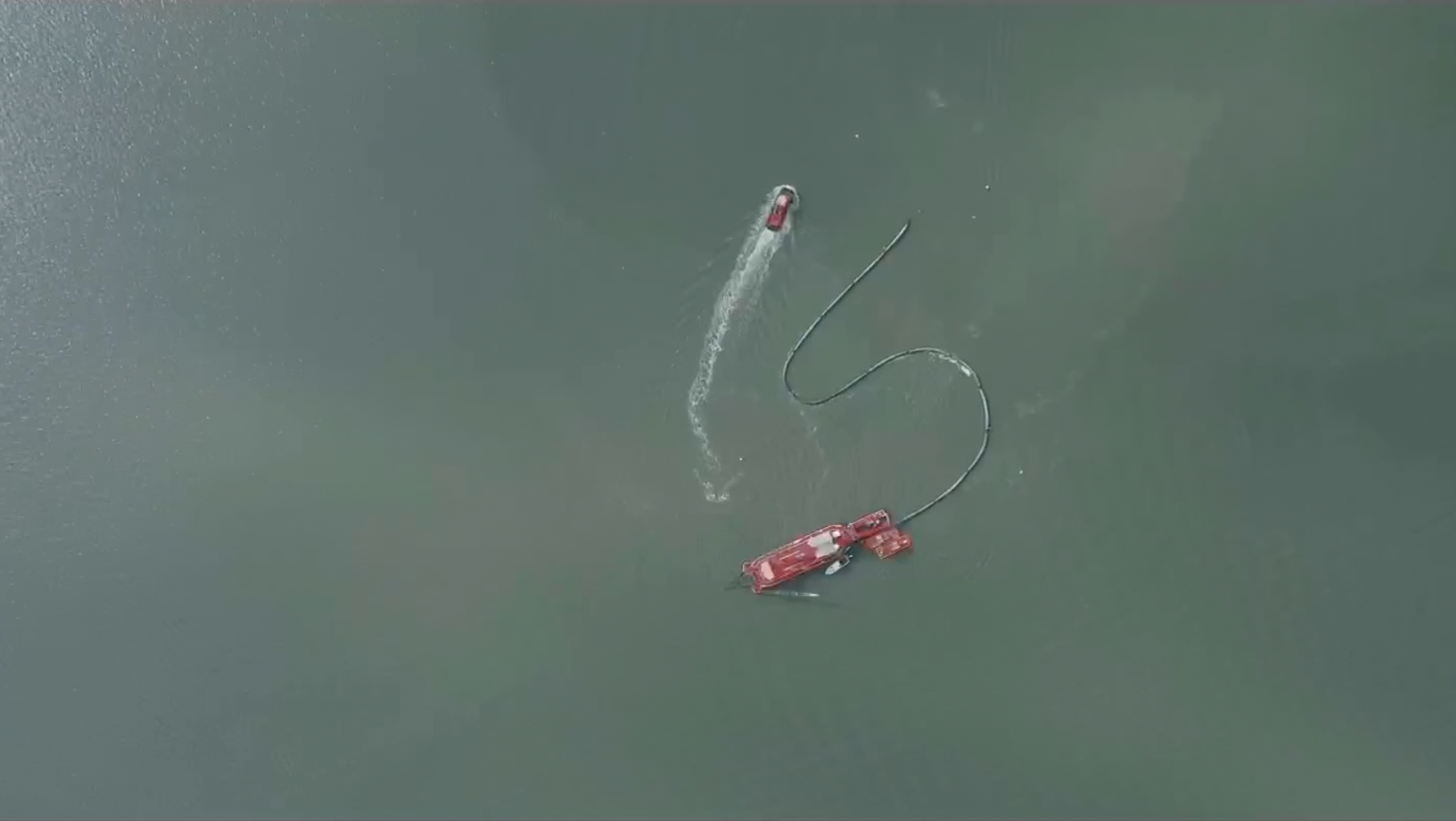U.S. Army Corps of Engineers (USACE) placed tpour of the foundation's sub-base at Deep Creek Bridge in the City of Chesapeake, Virginia on 9 February, 2024. (Courtesy photo by USACE Engineer Philip Abbott)
CHESAPEAKE, VIRGINIA - Since the successful tremie tube cement pour to lay a foundation for the bridge abutments on February 9th, the Deep Creek Bridge Replacement Project has since seen significant progress. The abutments are a structure which connects the deck of a bridge to the ground, at the ends of a bridge span, are crucial for connecting the bridge deck to the ground and supporting its weight, are being constructed with meticulous attention to soil quality, bridge dimensions, weight, and potential terrain hazards. At the time, the water above the initial cement pour in the cofferdam was approximately 32 feet deep.
U.S. Army Corps of Engineers removes debris after dewatering the cofferdam at Deep Creek Bridge in the City of Chesapeake, Virginia on 1 March, 2024. (Photo by James E Walker IV)
Since that time, engineers have employed a specialized pumping system to dewater the site, an essential step given the challenges posed by wet soil, particularly in areas with high water tables. Dewatering not only mitigates the risks associated with groundwater leakages and soil instability but also prepares the site for further construction phases.
Phillip Abbott, a U.S. Army Corps of Engineers (USACE) Engineer, elaborated on the process, stating, “the dewatering system effectively filters sediment from the water, allowing for a clean discharge. This step has revealed the cement sub-base, a 10-foot thick layer that serves as the foundation's bedrock. With the dewatering process complete and the cement pour pipes removed, workers are now refining the foundation, preparing for the next stages of construction.”
U.S. Army Corps of Engineers laborers refine concrete sub-base in the cofferdam at Deep Creek Bridge, City of Chesapeake, Virginia on 1 March, 2024. (Photo by James E Walker IV)
The project has also seen the installation of columns on the other side of the waterway which will aid the construction of abutments and facilitate the bridge’s subsequent ability to transfer the weight of vertical loads from the bridge superstructure to the foundation appropriately. The new $59.5 million, five-lane drawbridge will replace the existing two-lane bridge, enhancing accessibility along the Dismal Swamp Canal as an the Atlantic Intercoastal Waterway (AIWW). The AIWW which stretches from Norfolk, Virginia, to Miami, offers a protected inland channel for recreational boaters and commercial shippers alike.
For this reason, the significance of the Deep Creek Bridge’s functionality extends beyond local convenience and safety. In a recent "Corps Talk" podcast episode (above), USACE Engineer Chuck Sanders highlighted the national security implications of maintaining the Atlantic Intracoastal Waterways, recounting historical context.
“Federal maintenance of the AIWWs, initiated during World War I to protect commercial shipping from maritime threats. At that time, the American population had seen a massive amount of shipping damage that was being done to shipping vessels traveling unprotected between the ports of the American eastern seaboard where someone with a periscope and a torpedo could easily take out years worth of food and other resources. Providing an inland alternative gave commercial shippers some protection from that danger”, Sanders said.
The canal also played an important role following Hurricane Florence, facilitating emergency supply deliveries to Wilmington, NC, demonstrating the waterway's enduring value for both commercial and emergency logistics.
Sanders continued, “in 2018, the city was temporarily flooded and completely cut off from the outside world and the main commercial AIWW channel just south of us had also sustained substantial bridge damage, leaving limited options for shipping. The day after the storm cleared, Fort Eustis, which has the Army's main East Coast port and shipping setup, loaded three Army landing craft up with emergency supplies for Wilmington and subsequently navigated through the Deep Creek south to Wilmington because their boats were perfectly shallow enough to go right through.” Sanders explained that this was one of the first sets of supplies to make it to Wilmington after the storm thanks to Chesapeake’s nearly 140 year old Canal which many folks might find to be small and insignificant.
The partnership between the USACE - Norfolk District and the City of Chesapeake has been instrumental in driving the bridge replacement project forward since 1977 due to its inadequacy in handling traffic and failing to meet modern safety standards. Despite early challenges, a renewed effort in 1996 led to Congressional authorization and a feasibility study, ultimately recommending the bridge's replacement in 2003.
USACE-Norfolk District Commander, Col. Brian Hallberg, emphasized the Corps' commitment to the project, saying, "our mission here at USACE is to provide effective engineering solutions for the Nation’s and Commonwealth’s toughest challenges. Regarding the Deep Creek Bridge Replacement Project specifically, we know we're building a vital link for the community and the region. With that understanding, my team's focus and our commitment to the public is to ensure this bridge is completed safely and on time, to keep the lines of communication open both with the city and the community and to keep the public informed of what's happening.”
As the Deep Creek Bridge Replacement Project progresses, evidence of these words is easily seen today as residents drive over the bridge which remain open to transit during the construction process. USACE aims to complete the project by the fall of 2026 and encourages interested parties to visit the USACE website to learn more about the project and read periodic updates.
Click HERE to view a timeline for the construction process.
Click HERE for the City of Chesapeake Travel Advisories Calendar










